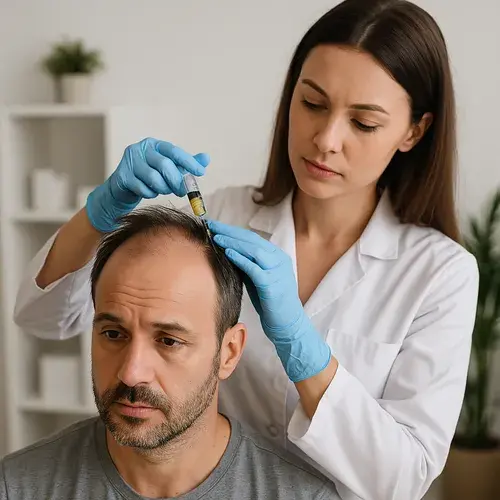New Treatments for Hair Loss on the Horizon: Emerging Non-Surgical Therapies in Development
Discover cutting-edge, non-surgical hair loss treatments—from hair cloning and exosome therapy to laser and PRP—offering natural, effective solutions with minimal downtime and side effects.

Hair loss is a common issue affecting millions of people worldwide, and while traditional surgical methods like hair transplants have been effective, they often come with significant downtime and potential side effects. Fortunately, the field of hair restoration is rapidly evolving, offering a variety of new and innovative non-surgical treatments that promise to revolutionize how we address hair loss. In this article, we will explore some of the most promising emerging therapies that are poised to transform the landscape of hair restoration. Hair Cloning: The Future of Hair Restoration One of the most exciting developments in hair restoration is hair cloning, also known as hair multiplication or hair follicle cloning. This technique involves replicating healthy hair follicles in a laboratory and transplanting them into areas with hair loss. Researchers are working tirelessly to develop effective methods for multiplying hair follicles, which could provide an almost limitless supply of donor follicles. While hair cloning is still in its experimental stages, several research initiatives have shown promising results. Scientists have successfully cloned hair follicles from a patient’s own cells, reducing the risk of rejection or adverse reactions. As this technology advances, it may soon become a viable solution for permanent and natural-looking hair restoration. Exosome Therapy: A Minimally Invasive Option Exosomes, tiny vesicles secreted by cells, are another groundbreaking area in hair restoration. These vesicles contain growth factors and signaling molecules that can stimulate hair follicle regeneration. In hair restoration procedures, exosomes are often extracted from a patient’s own cells or derived from other sources and then injected into the scalp. This minimally invasive therapy promotes hair growth, increases hair density, and may even halt hair loss. The popularity of exosome therapy is growing due to its non-surgical nature and potential to provide natural-looking results without the side effects associated with traditional treatments. Laser Hair Restoration: A Non-Invasive Solution Laser hair restoration has become a go-to solution for many in recent years due to its non-invasive nature and convenience. This method uses Low-Level Laser Therapy (LLLT) to stimulate hair follicles by increasing blood circulation to the scalp and encouraging cellular activity. By improving hair density and health, laser treatments are ideal for individuals with early to moderate stages of hair loss. They are often used to complement other therapies for optimal results. With ongoing advancements, lasers are becoming even more effective in promoting hair growth, making this treatment an exciting development in the field of hair restoration. PRP Therapy: Stimulating Hair Growth Naturally Platelet-rich plasma (PRP) therapy is another breakthrough in hair restoration. This method involves drawing the patient's blood, processing it to concentrate the platelets, and injecting it into the scalp. The platelets help to rejuvenate hair follicles, stimulate growth, and promote thicker hair. PRP is particularly beneficial for people experiencing early-stage hair loss and is becoming increasingly popular as a non-surgical treatment option. Its natural approach makes it an attractive alternative to surgical methods. Topical Treatments: The Future of Hair Loss Drugs The development of topical treatments for hair loss is also gaining momentum. Eirion Therapeutics has announced positive results for its first-in-man clinical trial of topical ET-02 in the treatment of androgenic alopecia. Additionally, a patented peptide formula, FOL005, is set to come to market in a topical gel form in 2025. These advancements in topical therapies offer new hope for individuals seeking effective treatments that can be applied directly to the scalp. Advanced Non-Invasive Clinical Treatments Beyond traditional methods, there are several advanced non-invasive clinical treatments that are gaining popularity. Autologous Micrografting Technology involves taking three small grafts of healthy hair follicles to create a suspension solution of follicle stem cells, which is then injected into the scalp. This method is effective at halting hair fall and rousing sleepy follicles to grow a thicker mane, with an 80% success rate in increasing hair density. Results can last up to 18 months, when top-up treatments can be administered. Another advanced delivery system is Tricopat hair restoration, which uses a dermabrasion tool with 0. 25mm needles to create micro wounds on the scalp. This aids penetration of growth-factor serum, increasing oxygen and nutrient supplies. The treated scalp is then exposed to an LED light, pressure wave, and electrostimulation, further increasing blood circulation and extending the growth ‘anagen’ phase of hair. A course involves four 20-minute sessions every three weeks. In conclusion, the horizon for hair loss treatments is filled with exciting new therapies that promise to revolutionize how we address this common issue. From hair cloning and exosome therapy to laser restoration and PRP injections, these emerging non-surgical treatments offer a range of options that are both effective and minimally invasive. As research continues to advance these technologies, individuals seeking solutions for hair loss can look forward to more natural-looking results with fewer side effects.
Need Professional Consultation?
Our professional doctors will provide detailed hair and scalp analysis and develop personalized treatment plans.
Book Consultation Now